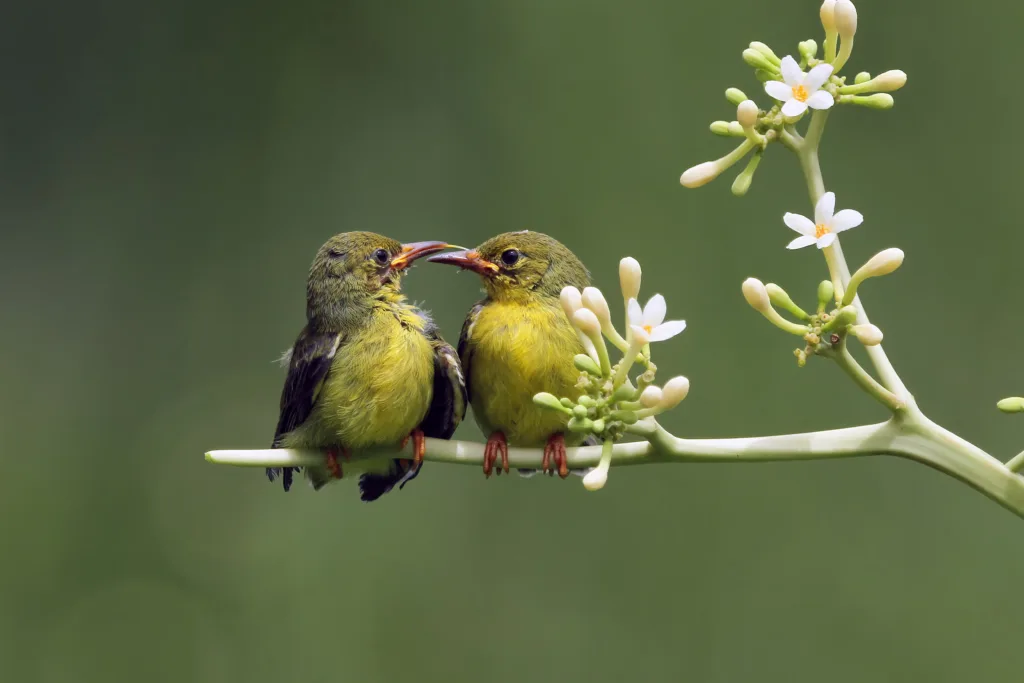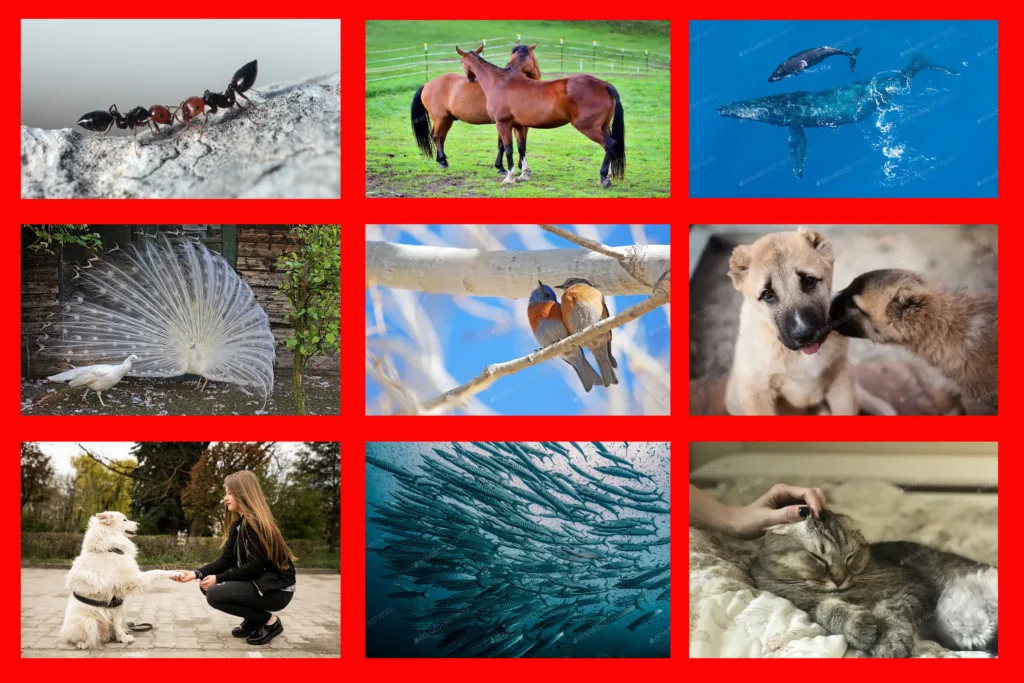Greetings are not exclusive to humans; they are woven into the fabric of the animal kingdom, serving a multitude of purposes in communication. In this exploration, we delve into the fascinating realm of animal greetings, shedding light on the diverse ways creatures express acknowledgment, establish connections, and convey messages.

Table of Contents
Introduction
In the vast tapestry of the natural world, greetings among animals are more than perfunctory gestures—they are integral to survival. From intricate vocalizations to elaborate body language, how animals greet each other provide a glimpse into the complex web of communication beyond our understanding.
Why Do Animals Greet?

Establishing Social Bonds
Social bonds are crucial for the survival of many species, and greetings play a pivotal role in forming and maintaining these connections. Whether it’s through the gentle nuzzling of primates or the intricate dance of birds, these gestures contribute to the cohesion of social groups.
Communicating Dominance or Submission
In the animal kingdom, hierarchy matters. Greetings often serve as a means of establishing dominance or submission, preventing unnecessary conflicts and maintaining order within a group.
Conveying Reproductive Signals
For many animals, greetings are intertwined with reproductive signals. From intricate courtship dances to pheromone releases, these behaviours play a significant role in the continuation of species.
The Varied Forms of Animal Greetings
Vocalizations
The world of animal greetings is a symphony of sounds. From the melodic songs of birds to the haunting calls of whales, vocalizations serve as a powerful means of communication across diverse species.
Body Language and Gestures
Animals express themselves through body language, using movements, postures, and gestures to convey messages. A wagging tail, a raised hoof, or a fluffed-up fur—all tell stories in the silent language of the animal kingdom.
Scent Marking
In the olfactory realm, scent marking is a prevalent form of greeting. Whether it’s rubbing of scent glands or spraying pheromones, animals leave messages that speak volumes to those who can decipher them.
Greetings in Mammals
Primates: Handshakes, Hugs, and Grooming
Our closest relatives, primates, engage in a wide array of greetings. From the gentle grooming rituals that strengthen social bonds to the elaborate handshakes that convey trust, these behaviours showcase the complexity of primate communication.
Canines: Sniffing and Tail Wagging
In the canine world, greetings often begin with a curious sniff. Tail wagging, a universal symbol of canine joy, is a form of greeting that transcends language barriers among dogs.
Felines: Headbutting and Slow Blinking
Cats, known for their independent nature, have subtle yet meaningful ways of greeting. Headbutting and slow blinking are gestures of trust and affection in the feline world.
Birds and Their Greetings
Songs and Calls
For birds, greetings are often accompanied by a symphony of songs and calls. These vocal displays serve not only as expressions of recognition but also as territorial markers and courtship invitations.
Ritualized Displays
Elaborate displays, from the intricate dances of birds of paradise to the synchronized flights of starlings, are captivating forms of greetings that transcend mere communication—they are performances in the grand theatre of nature.
Nest-Building as a Form of Greeting
In the avian world, the act of nest-building is not just a practical endeavour; it is a form of greeting. It signifies the creation of a home, a place where life will unfold.
Underwater Greetings
Dolphin and Whale Interactions
In the depths of the ocean, dolphins and whales engage in remarkable greetings. From playful acrobatics to synchronized swimming, these marine mammals display a level of social sophistication that mirrors our own.
Fish Communication Through Body Movements
Even in the underwater realm, greetings are expressed through body movements. From the shimmering displays of schooling fish to the territorial dances of crustaceans, the language of the sea is one of dynamic movements.
Insects and Invertebrates
Antennal Touching
In the world of insects, antennal touching is a delicate form of greeting. Ants, bees, and other social insects use their antennae to convey information about their environment and the individuals they encounter.
Vibrational Signals
Invertebrates, lacking vocal cords, resort to vibrational signals. Whether it’s the rhythmic tapping of spiders or the subtle vibrations of beetles, these intricate messages are crucial for survival and reproduction.
Chemical Exchanges
Pheromones, chemical messengers, play a pivotal role in invertebrate greetings. From attracting mates to marking territory, these chemical exchanges are a silent yet potent language in the small-scale world.
Cross-Species Greetings
Uncommon Instances of Different Species Greeting Each Other
While most greetings occur within the same species, there are intriguing instances of cross-species greetings. Whether driven by curiosity or mutual benefit, these interactions challenge our understanding of interspecies communication.
Theories Behind Cross-Species Greetings
Scientists explore the reasons behind cross-species greetings, delving into the potential benefits and evolutionary implications of these rare and captivating encounters.
Do Animals Recognize Individuals Through Greetings?
Research Findings on Animal Recognition
Studies reveal the remarkable ability of some animals to recognize individuals through their unique greeting behaviours. From the intricate calls of dolphins to the personalized grooming patterns of primates, these behaviours contribute to the formation of lasting bonds.
The Role of Memory in Animal Greetings
Memory, a powerful tool in animal cognition, plays a crucial role in recognizing individuals through greetings. The ability to recall past interactions contributes to the intricate web of social connections.
Human-Animal Greetings
Domestic Pets and Their Unique Ways of Greeting
Our relationships with domestic animals are enriched by unique forms of greetings. Whether it’s the joyous wagging of a dog’s tail or the gentle purring of a cat, these interactions enhance our understanding of the emotional depth within interspecies relationships.
The Therapeutic Impact of Human-Animal Greetings
Beyond companionship, human-animal greetings have therapeutic benefits. From therapy dogs providing comfort to individuals with disabilities to the use of equine-assisted therapy, these interactions showcase the healing power of interspecies connections.
The Role of Culture in Animal Greetings
Observing Variations in Greetings Within the Same Species
Even within a single species, variations in greetings can be observed. Cultural influences, environmental factors, and learned behaviours contribute to the diversity of animal greeting rituals.
Cultural Transmission of Greeting Behaviors
Certain greeting behaviours are passed down through generations, demonstrating the cultural transmission of knowledge within animal communities. This phenomenon highlights the complexity and adaptability of animal communication.
Greeting Rituals in Endangered Species
Challenges and Implications of Studying Greetings in Endangered Species
Studying greetings in endangered species poses unique challenges. Habitat loss, human interference, and the threat of extinction impact the natural behaviours of these animals, emphasizing the urgency of conservation efforts.
Conservation Efforts and the Impact on Animal Greetings
Conservation initiatives not only aim to protect species but also strive to preserve their natural behaviours, including greeting rituals. By understanding and respecting these behaviours, conservationists can better support the survival of endangered species.
Surprising Facts About Animal Greetings
Lesser-Known Examples of Unique Greetings
We need to explore lesser-known examples of animal greetings that defy expectations and showcase the diversity of communication strategies in the animal kingdom.
Evolutionary Perspectives on Greetings
We need to consider the evolutionary perspectives on greetings, exploring how these behaviours have developed and adapted over time to ensure the survival and success of different species.
Challenges in Studying Animal Greetings
Ethical Considerations
As researchers delve into the intricacies of animal greetings, ethical considerations arise. Balancing the need for knowledge with the welfare of the studied animals is a perpetual challenge in the scientific community.
Technological Advancements Aiding Research
Technological advancements, from remote sensing devices to non-invasive monitoring techniques, play a crucial role in advancing our understanding of animal greetings. These tools allow researchers to observe and analyze animal behaviours without undue interference.
Conclusion
In the grand tapestry of life, animal greetings are threads that weave intricate patterns of communication. From the depths of the ocean to the vastness of the sky, creatures engage in a dance of recognition and connection. Understanding these greetings not only deepens our appreciation for the richness of the natural world but also prompts us to reconsider the boundaries of communication that extend far beyond the realm of humans.
FAQs About Animal Greetings
- Q: Do all animals greet each other?
- A: While not all animals greet each other in the same way, most species exhibit some form of social acknowledgment or communication.
- Q: Are animal greetings instinctive or learned behaviours?
- A: Animal greetings can be a combination of instinctive behaviours and learned responses, varying across species.
- Q: How do researchers study animal greetings without disrupting natural behaviour?
- A: Researchers use non-invasive techniques, such as camera traps and remote sensors, to observe animal greetings without causing disturbance.
- Q: Can animals from different species understand each other’s greetings?
- A: In rare cases, animals from different species may exhibit cross-species communication, but the extent of understanding is still a subject of scientific investigation.
- Q: What role do animal greetings play in conservation efforts?
A: Studying animal greetings in endangered species helps conservationists understand and preserve natural behaviours, contributing to comprehensive conservation strategies.
